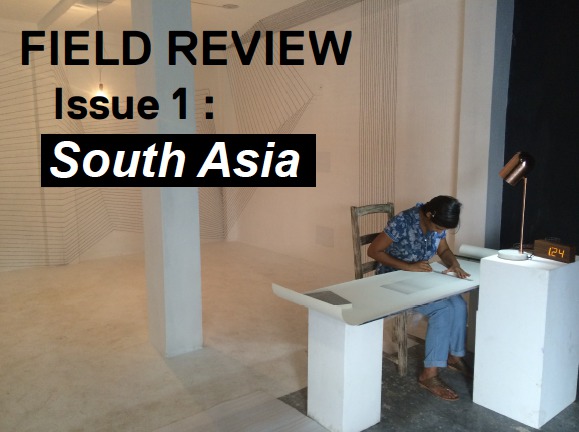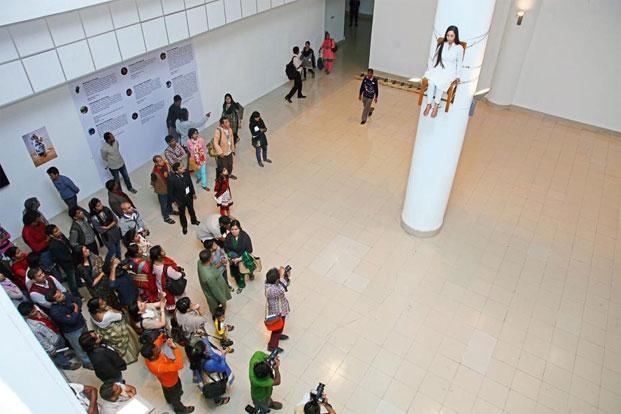FIELD REVIEW 1: SOUTH ASIA

Introduction
Meenakshi Thirukode
______________________________________
Abstraction De-Constructed through the Lens of Post-Colonialism
Achia Anzi
Grasping at the Untold
Jyoti Dhar
Kumar Vaidya: Through the Lens of Erasure and Invisibility
Meenakshi Thirukode
Yasmin Jahan Nupur: Dancing in the Non-Spaces of Performance
Zeenat Nagree
The Poetics of Absence and Presence in Parul Gupta’s Art: A Case for Revisiting Theories and Histories of Abstraction
Somak Ghoshal
The Immediacy Of Rejection: Music, Curation, and Sincerity in New India
Rana Ghose
______________________________________
About the Author
Meenakshi Thirukode
is currently a FICA Inlaks 2016-17 scholar at the MRes Curatorial/Knowledge, Goldsmiths, University of London. She is also the Curatorial Director at Exhibit 320 and its non-profit space 1After320. She is the co-founder Project For Empty Space, a non-profit which brings public art to abandoned and unusual urban spaces. Thirukode graduated with honors from the Masters program at Christies, in New York. She has written for both, local and international publications including ArtAsiaPacific, Art India, Whitewall Magazine, Fuschia Tree and The Hindu Newspaper, on contemporary art from South Asia. She has also curated exhibitions on South Asian contemporary art in New York and India. Thirukode has served on the board of the South Asian Womens Creative Collective (SAWCC) and Christies Alumni Board. She recently was the director of the New Media for Bushwick Film Festival, where she oversaw the setting up the department in its inaugural year at the 2013 festival and curating its program.
Introduction
Meenakshi Thirukode

Yasmin Jahan Nupur, Sat on a Chair, 2014. Performance at the Dhaka Art Summit, Dhaka, 2014. Courtesy of the artist and Samdani Art Foundation.
A trend is a definitive term. It is generally understood as a movement or direction that dominates above and beyond those that run parallel and often times within the subaltern. In 2008, for instance, curator Vidya Shivdas with advisory input from Sonal Khullar curated ‘Fluid Structures – Gender and Abstraction’ at Vadhera Art Gallery, New Delhi that explored the contribution of six women artists spanning two generations, to the history of abstraction in India. They included Nasreen Mohamedi, Zarina Hashmi, Arpita Singh, Gargi Raina, Sheila Makhijani and Manisha Parekh. Now in 2016 the inaugural show at The MET Bruer, New York was a retrospective of Nasreen Mohamedi – the show touted by the curators as ‘adding a rich layer to the history of South Asian art but also necessitates an expansion of the narratives of international modernism.’
This issue attempts to ‘observe’ and then present perspectives of what are now inescapable patterns within the global art world history where many locals within art histories are made ‘visible’ only when international institutional visibility necessitates its excavating or even weaving together. It questions whose ‘history of South Asia’ is being referred to and being expanded upon?
In this context six essays look at ‘Abstraction’ within visual arts in South Asia not necessarily by making connections chronologically within art history alone, but also by investigating the relationships between visual artists and other cultural producers including poets, filmmakers, musicians, philosophers, architects in order to navigate through broader socio-political and psychological explorations, research and cultural production.
Achia Anzi explores the apparatus of abstraction in art from a postcolonial perspective through the artworks of the Indian painter Atul Dodiya and with a special emphasis on his series Painted Photographs/Paintings Photographed. Jyoti Dhar‘s essay ‘Grasp: Instruments and Mechanics’ focuses on the work of artists such as Sybil Keyt, Susila Wijesuriya and Sita Kulaseker who were seemingly critically engaged, intellectually influential and yet inexplicably left out of the main history of modernism (with the ’43 group) in Sri Lanka. In a similar vein to the ‘grasping’ of lost histories, Meenakshi Thirukode looks at the seminal practice of artist Kumar Vaidya, whose formal and aesthetic language developed since the 1980’s has largely gone unrecognized or even, critically engaged with.
Zeenat Nagree considers the performative elements of Yasmin Jahan Nupur’s practice in relation to the histories of abstraction, architecture and modernism in Bangladesh while Somak Ghosal focuses on the poetics of absence and presence in Parul Gupta’s practice given the architectural precision of her work and its minimalist focus.
In the case of India, and perhaps the region itself, there is a form of neo-colonization that occurs. The narratives built are merely ways of being able to validate practices as being of a particular genre dictated by the push and pull of the market, in order for the same narrative to perpetuate – a way for a few players to find credibility by association to that fraught context of ‘globalism’.
Rana Ghose’s essay addresses the role of an immersive, truly independent curated experimental music/sound/noise series called REProduce Listening Room to explore how South Asian musical authorship rejects and recasts the identity politics that pop culture has mirrored, both in the sonic and market context.
The essays stem from an editorial prompt as a means to also look introspectively at the role of the writer in this pivotal moment while constructing and formulating their ideas around this genre’s histories. The prompts include ‘Distance’, ‘Invisibile-Visible’, ‘Slowness’, ‘Grasp’, ‘Movement’, ‘Opacity’, ‘Rootedness’. The five prompts that I have set for the writers are ways in which to present a set of ideas, thoughts, arguments, that confront and engage with what is now seen as a ‘genre’ that does two things – one, it places South Asian art within a larger art history that is fluid as opposed to being definitive. What is of interest is that this is occurring simultaneously to the surge of research and publications beyond South Asia that bring to light the fact that ‘Abstraction’ and ‘Abstract Expressionism’ was not purely a ‘white man’s’ genre, even though that was the dominant narrative.
And two, the more important impetus for this set of writing, is that it offers perhaps a way to not fall into existing relations between art history and the market. It looks at the way in which each writer in some way must grapple with his/ her own ways of writing, contextualizing and thinking about their practice. Its relevance, its power, its significance and its grappling with truths, of what their actual role is – tethered between holding on to the integrity of ones voice and keeping a distance, while sometimes being drawn into the quagmire of a market centric ‘branding’ exercise cloaked as critique.
There is a need to look at both curatorial practice and art criticism as intertwined roles in a region whose contemporary art histories have been pre-dominantly dictated by the market. What possibilities lie when there are less fixed ways of looking at the role of the academic, the art writer, artist and curator in shifting the narrative beyond the many binaries that form because discourse is inexplicably tied in to the dictates of the art market and its demands? With the work of organizations that look to create archives of art histories in the region accessible, both to artists and slowly to a larger public, what becomes apparent is that the region of South Asia can construct many art histories that re-imagine the relationship of many locals with the many globals. Definitive structured art histories to re-imagine don’t exist in the way it might within Euro-American art histories, rather what exists are anecdotal and collective histories constructed from personal archives. What is largely happening at some level within the region broadly defined as South Asia is that possibilities to look at the past and construct a future that doesn’t look like the present is still fluid.
In the case of India, and perhaps the region itself, there is a form of neo-colonization that occurs. The narratives built are merely ways of being able to validate practices as being of a particular genre dictated by the push and pull of the market, in order for the same narrative to perpetuate – a way for a few players to find credibility by association to that fraught context of ‘globalism’.


